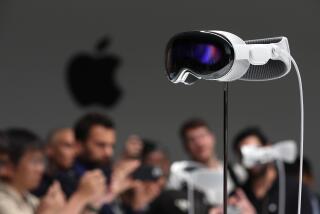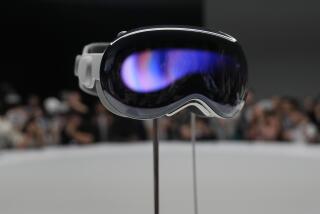IPad less than revolutionary for now, but holds great promise
- Share via
Only Steve Jobs could make anticlimax seem so fascinating.
After the Apple CEO unveiled his company’s most fervently anticipated new product at an invitation-only media event Wednesday, most of the anticipation was left in the bottle.
Despite months of hype heralding an entirely novel kind of electronic device, the reality was underwhelming. The iPad resembles a scaled-up iPhone -- without the phone. It’s an iPod too big to fit in your pocket yet too small in capacity to hold your entire music collection, with a Web browser featuring excellent graphics but tied to a data network (AT&T’s) so slow and spotty that its announcement drew groans from people in the audience. Like the iPhone, it’s a closed system, meaning that you can’t use it to run an application that hasn’t been approved by Apple.
(Apple did negotiate an attractive wholesale price for data plans, though -- $30 a month for unlimited data, no long-term contract required.)
Notable among the iPad’s missing features is a built-in camera for videoconferencing and video chats. Even netbooks, which got the back of Jobs’ hand during his Wednesday presentation, have those, as well as real keyboards for note-taking, novel-writing or blog-posting.
Like the iPhone, the iPad has a virtual keyboard that appears onscreen and seems useless for anything other than replying to e-mails in cyber-shorthand.
Wednesday morning, you could track the palpable deflation among those attending Apple’s event by following their Twitter feeds from the auditorium at San Francisco’s Yerba Buena Center: “Nothing mindblowing yet” . . . “Many disappointments so far” . . . (and finally) “This crowd is dying of boredom.”
That’s not even counting the expectations stirred up by tech pundit Jason Calacanis, who claimed the night before to have been testing a model with two cameras, a built-in video recorder and a solar grid for charging. The iPad, which will be available in 60 days here on planet Earth, has none of those things.
Some tech mavens believed the new device might finally fulfill the promise of the “Dynabook.” This is a device conceived four decades ago by the visionary computer pioneer Alan Kay as a prototypical personal computer (this was before Kay actually conceived the first personal computer at the legendary Xerox Palo Alto Research Center). The Dynabook, he wrote in 1972, would be “a tool, a toy, a medium of expression, a source of unending pleasure and delight.” It would be a device with which musicians could compose and authors write, teachers teach and children learn. It would offer electronic access to the world’s libraries. It would have a high-quality flat screen and a keyboard. It would be less than 4 pounds.
The iPad is 1.5 pounds, but in other ways it still falls short of the Dynabook, especially in the inadequacy of its keyboard. (Though it will accommodate Brushes, an onscreen painting program available on the iPhone.) It’s still a device better suited to distributing than to creating content.
Yet the iPad shouldn’t be judged by how far it falls short of users’ fantasies, much less Kay’s ideal. Apple’s position as the world’s premier consumer electronics company is based not on its development of new technologies, but on its reconceiving of existing technologies to make them infinitely more useful.
The company is especially effective at designing its devices around content. Miniature hard drives, earphone jacks and click wheels existed before 2001, but it took the iPod to make your entire music collection portable. Cellphones and music players existed before 2007, but it took Apple to put them together as the iPhone.
It shouldn’t come as a surprise that the iPad looks like a major refinement in the digital distribution of entertainment and information, an area where others have taken the first imperfect steps.
Start with eBooks. It’s hard to see the iPad as anything other than a mortal threat to Amazon.com’s market-leading Kindle reader.
Today you can buy a top-of-the-line Kindle, the DX, for $489. For that you get 4 gigabytes of storage, enough to hold (Amazon says) 3,500 books. The Kindle features a 9.7-inch screen of a monochrome gray that the novelist Nicholson Baker described in the New Yorker last year as “a greenish, sickly gray. A postmortem gray” that was a “four-by-five window onto an overcast afternoon.”
For only $10 more, you can have Apple’s entry-level iPad, with four times as much storage, a high-contrast full-color screen -- also 9.7 inches diagonally -- a dedicated eReader application that looks as if it will be less clunky than the Kindle’s, and Web-browsing capability that the Kindle lacks. It’s reasonable to assume that from now on, every $500 eReader will have to match the iPad’s specifications.
Much of the pre-launch speculation concerned whether Apple’s new device might rescue newspapers and magazines from the dead end of free online content, which has helped corrode their business model. This remains a promising possibility.
Simply converting from free to fee will be a difficult transition unless customers are led to believe they’re buying something new. The iPad could be a key to that, just as Apple’s iTunes Music Store pioneered the transition from free, pirated digital music files to the legal 99-cent song. Before iTunes and the iPod, digital music consumers had only two choices: download songs from the record labels’ websites or snort up illegal copies from cyberspace.
The iPad offers the ability to launch integrated audio and video clips along with a news story. That will allow publishers to create a new, modern form of newspaper and magazine content, thoroughly reported like the best periodical journalism, and enhanced with a you-are-there immediacy -- something new that publishers can start charging for, whether by the article or by subscription. But the publishers are going to have to develop the right sort of material.
The iPad doesn’t evoke for me Kay’s concept of the Dynabook so much as another technology he has often talked about -- the portable book invented by the 15th century Venetian printer Aldus Manutius.
Aldus supplanted the huge, expensive Bibles of Gutenberg with editions that could fit in a saddlebag and were cheap enough to risk losing on the road. Aldus, more than Gutenberg, set the book on the path to popular utility. In the same way, the iPad may help reformat the book, the newspaper and the Web to fit our modern, mobile lifestyle to creators, publishers, distributors and readers alike.
Steve Jobs closed his presentation Wednesday by proclaiming the iPad to be “a magical and revolutionary device.” It’s much less than that, now. But depending on how it’s exploited, eventually it could be much more.
Michael Hiltzik’s column appears Mondays and Thursdays. Reach him at [email protected], read earlier columns at www.latimes.com/hiltzik, and follow @latimeshiltzik on Twitter.







